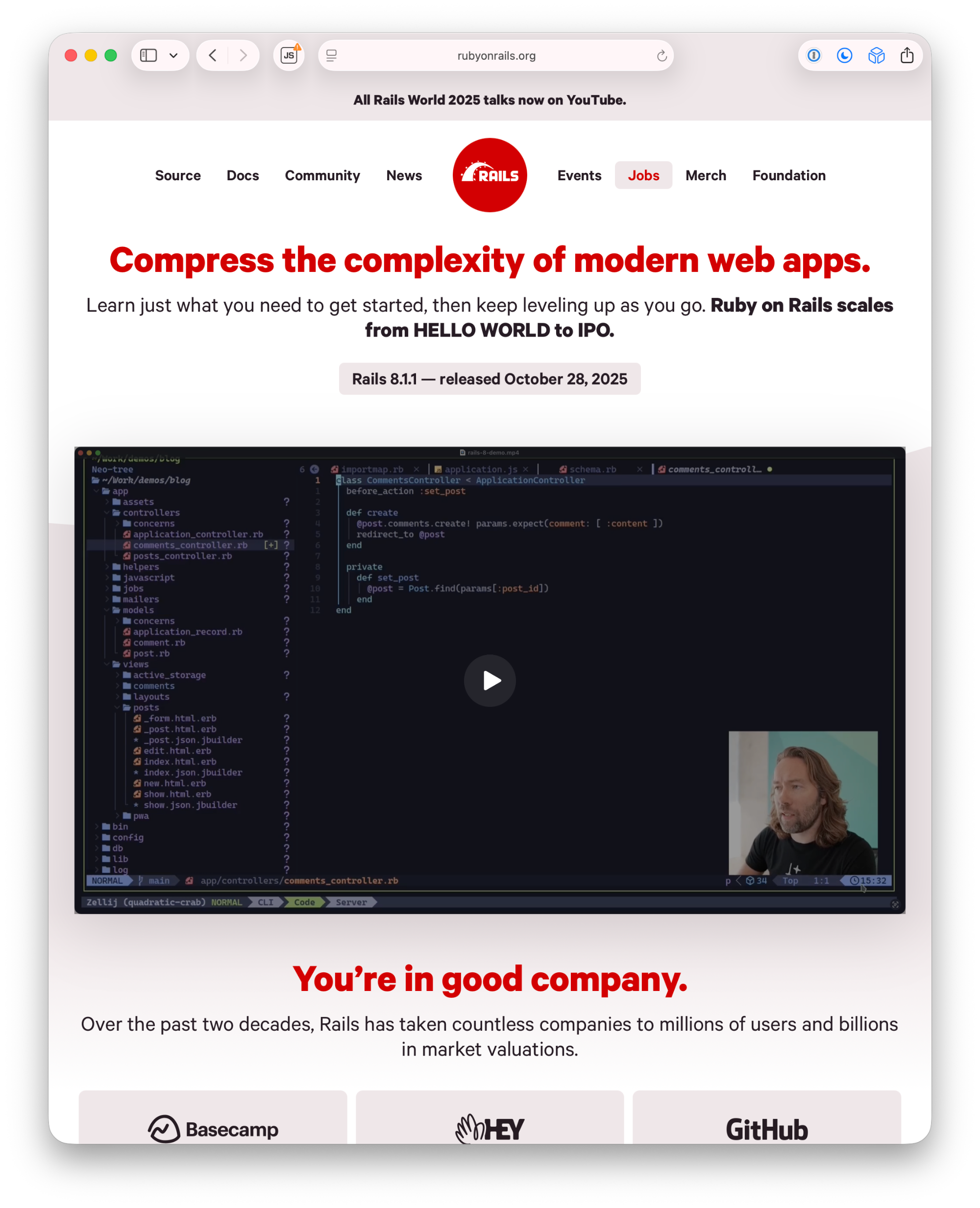Why Rails?
Rails is a highly productive full-stack framework. There’s ample documentation on “Why Rails,” so I won’t cover that here, but I will cover the question of “Why Rails and Phlex?”
Rails has most of the parts you need to build a web application
Rails prides itself on “compressing the complexity of modern web apps.” That means when you run rails new, you’ll get most of the parts you need to build a web application:
🔓 Unlock content
Purchase this course to unlock this video, source code, and content.
- ▓▓▓▓▓▓▓▓▓▓▓▓ ▓ ▓▓▓▓▓▓▓▓ ▓▓▓▓▓▓▓▓▓▓▓ ▓▓▓▓ ▓▓ ▓▓▓ ▓▓▓ ▓▓▓▓▓▓ ▓▓▓ ▓▓▓▓▓▓▓▓▓▓
- ▓▓▓▓▓▓▓▓▓▓▓▓▓▓▓▓ ▓ ▓▓▓▓▓▓▓▓▓▓▓ ▓▓▓▓ ▓▓▓▓▓▓ ▓▓▓▓ ▓▓▓▓▓▓▓▓ ▓▓▓ ▓▓▓▓▓▓▓▓▓
- ▓▓▓▓▓▓▓▓▓▓ ▓ ▓▓▓▓ ▓▓▓▓▓▓▓▓▓▓ ▓▓▓▓▓▓ ▓▓▓▓ ▓▓▓▓ ▓▓▓▓▓▓▓▓▓ ▓▓▓ ▓▓▓▓▓▓▓
- ▓▓▓▓▓▓▓▓▓ ▓ ▓▓▓▓▓▓▓▓▓▓ ▓▓▓ ▓▓▓▓▓▓▓▓▓▓
- ▓▓▓▓▓▓▓▓▓▓▓ ▓ ▓▓▓▓▓▓▓▓▓▓ ▓▓▓ ▓▓▓▓▓▓▓▓▓ ▓▓▓▓▓▓▓▓
- ▓▓▓▓▓▓▓▓▓▓▓▓ ▓ ▓▓▓▓▓ ▓▓▓▓▓▓▓▓ ▓▓▓▓▓▓
- ▓▓▓▓▓▓▓▓▓▓▓▓▓ ▓ ▓▓▓▓ ▓▓▓▓▓▓ ▓▓▓ ▓▓▓▓▓▓▓ ▓▓▓▓▓▓▓▓
- ▓▓▓▓▓▓▓▓▓▓ ▓ ▓▓▓▓ ▓▓▓▓ ▓▓▓▓▓▓▓
- ▓▓▓▓▓▓▓ ▓ ▓▓▓ ▓▓▓▓▓▓▓ ▓▓ ▓▓▓▓▓▓▓▓▓▓▓
- ▓▓▓▓▓▓▓ ▓ ▓▓▓▓▓▓▓▓ ▓▓▓▓ ▓▓▓▓▓▓▓▓▓ ▓▓▓▓ ▓▓▓▓▓▓▓▓ ▓▓▓ ▓▓▓▓▓▓▓▓▓▓
- ▓▓▓▓▓▓▓▓▓▓▓▓ ▓ ▓▓▓▓▓▓▓▓▓▓▓▓▓ ▓▓▓ ▓▓▓▓▓▓▓▓▓▓▓▓ ▓▓▓▓▓ ▓▓▓ ▓▓▓▓▓▓▓▓▓▓
▓▓▓ ▓▓▓▓ ▓▓▓▓▓ ▓▓▓ ▓▓ ▓▓▓▓▓ ▓▓▓▓▓ ▓▓▓▓ ▓▓▓▓▓▓▓▓ ▓▓▓▓▓▓▓▓▓▓ ▓▓▓ ▓▓ ▓▓▓ ▓▓▓▓
Rails will be around for a while and is the de facto standard for Ruby web frameworks
▓▓ ▓▓▓ ▓▓▓▓▓ ▓ ▓▓▓ ▓▓▓▓▓▓▓▓▓▓▓ ▓▓ ▓▓▓▓▓▓ ▓▓▓ ▓▓▓▓▓ ▓▓▓▓ ▓▓ ▓▓▓▓▓ ▓▓▓▓▓ ▓▓▓▓▓▓▓ ▓▓ ▓▓▓▓ ▓▓ ▓▓▓▓▓▓▓▓▓ ▓▓ ▓▓ ▓▓▓ ▓▓ ▓▓▓▓ ▓▓ ▓▓▓▓▓▓ ▓▓▓▓ ▓▓▓▓▓▓▓▓▓ ▓▓▓▓▓▓▓▓▓ ▓▓▓▓▓▓▓ ▓▓▓▓▓▓▓ ▓▓▓▓▓▓▓▓ ▓▓▓ ▓▓▓▓ ▓▓▓▓ ▓▓▓▓ ▓▓▓▓▓ ▓▓▓▓▓▓▓▓ ▓▓ ▓▓▓▓▓▓▓▓ ▓▓ ▓▓▓▓▓▓▓▓ ▓▓▓▓▓ ▓▓ ▓▓▓▓▓▓▓▓▓▓ ▓▓ ▓▓ ▓▓▓ ▓▓▓▓ ▓ ▓▓▓▓▓▓ ▓▓▓▓▓▓▓▓ ▓▓ ▓▓▓▓▓▓▓ ▓▓▓ ▓▓▓▓▓▓▓▓▓ ▓▓▓▓▓ ▓▓▓ ▓▓▓▓▓▓▓▓
Rails is very modular
▓▓▓ ▓▓▓▓▓▓▓ ▓▓▓▓▓ ▓▓▓▓▓ ▓▓▓▓▓ ▓▓ ▓▓▓ ▓▓▓▓▓▓▓ ▓▓ ▓▓▓ ▓▓▓▓▓ ▓▓▓▓ ▓▓▓ ▓▓▓▓▓▓▓ ▓▓▓▓▓▓▓▓ ▓▓ ▓▓▓▓▓▓▓▓▓▓ ▓▓▓▓▓▓▓▓▓ ▓▓▓ ▓▓▓▓▓▓▓▓ ▓▓ ▓▓▓▓▓▓▓▓ ▓▓▓▓ ▓▓ ▓▓▓ ▓▓▓ ▓▓▓▓▓▓▓▓▓ ▓▓▓▓ ▓▓▓ ▓▓▓▓▓ ▓▓▓▓▓ ▓▓▓▓▓ ▓▓▓▓▓▓
Phlex can be dropped into Rails
▓▓▓ ▓▓▓▓▓▓▓▓▓▓▓ ▓▓▓▓▓ ▓▓▓▓ ▓▓▓▓▓ ▓▓▓▓▓▓▓▓▓▓▓ ▓▓▓▓ ▓▓▓ ▓▓▓▓▓▓▓▓▓▓ ▓▓▓▓▓▓▓▓▓ ▓▓▓ ▓▓▓▓▓▓▓▓ ▓▓▓▓▓▓ ▓▓▓ ▓▓▓▓ ▓▓▓▓▓▓▓▓▓▓ ▓▓▓▓▓▓ ▓▓▓▓▓▓▓▓▓▓▓▓▓▓▓ ▓▓▓▓▓▓▓▓▓▓▓▓▓▓ ▓▓▓ ▓▓▓▓▓▓▓ ▓▓▓▓▓▓▓ ▓▓▓▓ ▓▓▓▓▓▓▓▓
▓▓▓▓▓ ▓▓▓▓▓ ▓ ▓▓▓▓▓▓▓▓▓▓ ▓▓▓▓▓▓▓▓ ▓▓▓▓▓ ▓▓▓▓▓▓▓▓▓▓ ▓▓▓ ▓▓▓▓▓ ▓▓▓▓ ▓▓▓▓▓▓▓ ▓▓▓▓ ▓▓▓▓▓▓▓▓ ▓▓▓▓ ▓▓▓▓▓▓▓▓▓▓▓▓ ▓▓▓▓▓ ▓▓▓ ▓▓▓▓▓ ▓▓▓▓▓▓▓ ▓▓ ▓▓▓▓ ▓▓▓▓▓▓▓▓▓▓▓ ▓▓▓ ▓▓▓▓▓ ▓▓▓▓ ▓▓▓▓▓ ▓▓▓▓ ▓▓▓▓▓▓ ▓▓▓▓▓ ▓▓▓▓▓▓▓ ▓▓ ▓▓▓▓▓▓▓▓▓▓
class CardComponent < ▓▓▓▓▓::▓▓▓▓
def ▓▓▓▓▓▓▓▓
▓▓▓(class: "card") do
▓▓ { "Hello World" }
p { "This is pure Ruby" }
end
end
end
▓▓▓▓▓▓▓▓▓▓▓▓▓ ▓▓ ▓▓▓▓▓▓▓▓ ▓▓▓▓▓▓▓▓▓ ▓▓▓▓▓▓▓▓▓ ▓▓▓▓ ▓▓▓▓ ▓▓▓▓ ▓▓▓▓▓▓▓ ▓▓▓▓▓▓ ▓▓▓▓ ▓▓▓ ▓▓▓▓▓▓▓▓▓▓ ▓▓▓▓ ▓▓▓▓ ▓▓▓▓▓▓▓▓▓▓▓▓ ▓▓▓▓▓▓▓ ▓▓▓ ▓▓▓▓▓▓▓▓▓▓ ▓▓▓▓▓▓▓ ▓▓▓▓ ▓▓▓▓▓ ▓▓▓ ▓▓▓▓ ▓▓▓▓▓▓▓▓▓▓
▓ ▓▓▓▓▓▓▓▓▓▓▓▓▓▓▓▓▓▓▓▓▓▓▓▓▓▓▓▓▓▓▓▓▓▓
class CardComponent < ▓▓▓▓▓▓▓▓▓▓▓▓▓::▓▓▓▓
def ▓▓▓▓▓▓▓▓▓▓(▓▓▓▓▓:)
▓▓▓▓▓▓ = ▓▓▓▓▓
end
end
▓▓▓ ▓▓▓▓▓▓▓▓▓▓▓▓▓▓▓▓▓▓▓▓▓▓▓▓▓▓▓▓▓▓▓▓▓▓▓ ▓▓
▓▓▓▓ class="card"▓
▓▓▓▓<%= ▓▓▓▓▓▓ %>▓▓▓▓▓
▓▓▓This uses ERB templates▓▓▓▓
▓▓▓▓▓▓
▓▓▓▓ ▓▓▓▓ ▓▓▓▓▓▓▓▓▓▓ ▓▓▓▓ ▓▓▓▓▓▓ ▓▓▓ ▓▓▓▓▓▓▓ ▓▓▓▓ ▓▓▓▓ ▓▓▓▓▓▓▓▓ ▓▓▓▓▓ ▓▓ ▓▓▓▓▓▓▓ ▓▓▓▓▓▓▓▓▓ ▓▓▓▓▓▓▓ ▓▓▓▓ ▓▓▓ ▓▓▓▓ ▓▓▓▓▓▓ ▓▓▓ ▓▓▓▓▓▓▓▓ ▓▓▓ ▓▓▓▓▓▓ ▓▓▓▓▓▓▓▓ ▓▓ ▓▓▓▓▓ ▓▓▓▓▓ ▓▓▓▓▓▓▓▓▓▓▓▓ ▓▓▓ ▓▓ ▓▓▓▓▓▓▓▓ ▓▓▓▓ ▓▓▓▓ ▓▓▓▓▓▓▓▓ ▓▓ ▓▓▓▓▓ ▓ ▓▓▓▓▓ ▓▓▓▓▓▓▓▓▓▓▓ ▓▓▓ ▓▓▓▓▓▓▓▓▓▓▓ ▓▓▓▓ ▓▓ ▓▓▓ ▓▓▓ ▓▓▓▓ ▓▓▓▓▓▓
Less JavaScript with Hotwire
▓▓▓ ▓▓ ▓▓▓ ▓▓▓▓ ▓▓▓▓▓▓▓▓▓ ▓▓▓▓▓▓ ▓▓▓▓▓ ▓▓▓▓▓▓▓ ▓▓▓▓ ▓▓▓▓▓▓▓▓▓▓ ▓▓ ▓▓▓▓▓▓▓▓ ▓▓▓ ▓▓▓ ▓▓▓▓▓▓▓▓▓▓▓▓▓ ▓▓▓▓▓▓▓ ▓▓▓ ▓▓▓▓▓▓▓ ▓▓▓ ▓▓ ▓▓▓▓▓▓▓ ▓▓▓▓ ▓▓▓▓▓▓▓ ▓▓▓ ▓ ▓▓▓▓▓▓▓ ▓▓▓ ▓▓▓▓▓▓▓▓ ▓▓▓▓▓▓▓▓▓▓▓▓▓
▓▓▓▓▓▓ ▓▓▓▓▓▓▓▓ ▓▓ ▓▓▓▓▓▓▓▓▓▓ ▓▓ ▓▓ ▓▓▓ ▓▓▓▓ ▓▓ ▓▓ ▓▓▓▓▓▓▓ ▓▓ ▓▓▓▓▓▓▓▓ ▓▓▓▓▓ ▓▓ ▓▓▓▓▓▓▓▓▓▓▓▓▓▓▓▓▓▓▓▓ ▓▓▓▓ ▓ ▓▓▓▓▓▓▓ ▓▓▓▓▓▓ ▓▓▓▓▓▓▓▓
▓▓▓ ▓▓▓▓ ▓▓▓▓▓▓ ▓▓▓▓▓▓▓ ▓▓ ▓▓ ▓▓▓ ▓▓▓ ▓▓▓▓▓▓ ▓▓▓▓▓▓ ▓▓▓▓ ▓▓▓▓▓▓▓▓ ▓▓▓▓▓▓ ▓▓▓▓▓ ▓▓▓ ▓▓▓▓ ▓▓ ▓▓ ▓▓▓▓▓▓▓ ▓▓ ▓▓▓▓▓ ▓▓▓▓ ▓▓▓ ▓▓▓▓▓▓▓▓▓ ▓▓▓▓ ▓▓▓▓ ▓▓ ▓ ▓▓▓▓▓▓▓▓▓ ▓▓▓▓ ▓ ▓▓▓▓▓▓▓▓▓▓▓ ▓▓▓▓▓▓▓▓ ▓▓▓▓ ▓▓ ▓▓▓▓▓▓▓▓▓▓▓▓ ▓▓▓▓ ▓▓▓▓▓▓▓▓ ▓▓▓▓▓▓▓▓▓ ▓▓▓▓ ▓▓▓ ▓▓▓▓▓▓▓▓▓ ▓▓▓▓▓▓▓ ▓▓ ▓▓▓▓▓▓▓▓▓▓▓▓▓ ▓▓▓ ▓▓▓▓ ▓▓▓▓▓ ▓▓▓▓ ▓▓▓ ▓▓▓▓▓ ▓▓▓▓▓▓ ▓▓▓▓▓▓▓▓▓▓▓ ▓▓▓ ▓▓▓▓▓▓▓▓
Hotwire works with native mobile apps
▓▓▓▓▓▓▓ ▓▓▓▓ ▓▓ ▓▓▓▓▓▓ ▓▓▓▓▓▓▓▓▓ ▓▓▓▓▓▓ ▓▓▓▓▓▓▓ ▓▓▓▓▓▓ ▓▓▓▓▓▓▓ ▓▓▓▓▓▓ ▓▓▓▓ ▓▓▓▓▓ ▓▓▓▓▓▓▓▓▓▓▓ ▓▓▓▓ ▓▓▓ ▓▓▓▓▓▓▓▓▓▓▓ ▓▓▓▓ ▓▓▓▓▓▓ ▓▓▓▓▓▓ ▓▓▓▓ ▓▓▓▓ ▓▓▓▓▓▓▓▓▓▓▓▓▓▓▓ ▓▓▓ ▓▓▓▓▓ ▓▓▓▓▓▓▓
A pragmatic community
▓▓▓▓▓ ▓▓▓▓▓▓▓▓▓▓ ▓▓▓▓▓▓▓▓▓ ▓▓▓▓▓ ▓▓ ▓▓▓▓▓▓▓▓ ▓▓▓▓▓▓▓▓ ▓▓ ▓▓▓▓▓▓ ▓▓▓▓ ▓▓▓ ▓▓▓▓▓▓▓ ▓▓▓▓▓▓ ▓▓ ▓▓▓▓▓▓ ▓▓▓▓▓▓▓▓▓ ▓▓▓▓ ▓▓▓▓▓▓▓ ▓▓▓▓▓▓▓▓ ▓ ▓▓▓▓▓▓▓▓▓ ▓▓▓▓ ▓▓▓▓▓ ▓▓▓▓▓▓▓ ▓▓ ▓▓▓▓▓▓ ▓▓▓▓ ▓▓▓ ▓▓▓▓▓▓▓▓▓▓▓▓▓ ▓▓▓▓ ▓▓▓▓▓▓ ▓▓▓▓▓▓▓ ▓▓ ▓▓▓ ▓▓▓▓▓▓▓▓▓ ▓▓ ▓▓▓▓ ▓▓▓▓▓ ▓▓▓ ▓▓▓▓▓▓ ▓▓▓▓ ▓▓ ▓▓▓▓▓▓▓▓▓ ▓▓▓▓▓▓▓▓▓ ▓▓ ▓▓▓ ▓▓▓▓ ▓▓▓▓▓▓▓▓ ▓▓▓▓▓▓▓▓

